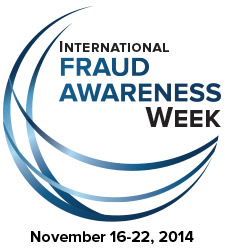2014 Fraud Awareness Week Highlights Impact of Fraud and Tips for Prevention

This week is International Fraud Awareness Week, a global effort led by the Association of Certified Fraud Examiners (ACFE) to minimize the impact of fraud by promoting anti-fraud awareness and education.
We are proud to be among almost 1,000 organizations supporting this effort through the publication and distribution of educational materials that can help managers identify fraud risks and develop mitigation programs. This week we will feature fraud prevention-related content on our blog and we have issued a special edition of The Risk Mitigator. We are also proud to announce the release of our visual guide, 10 Fraud Facts. The guide highlights 10 facts about fraud from the ACFE’s 2014 report and offer tips to help your organization develop an effective fraud prevention program. Get your copy here.
Awareness of the potential for organizational fraud is the first step toward prevention. Yet a surprising number of organizations have no systematic fraud detection and prevention policies in place, leaving them more vulnerable to this hidden crime than they need to be.
ACFE’s Report to the Nations on Occupational Fraud and Abuse
The ACFE has contributed greatly to the awareness of fraud with its biennial series titled Report to the Nations on Occupational Fraud and Abuse. The 2014 edition is based on 1,483 cases of organizational fraud worldwide during 2013, reported by the Certified Fraud Examiners who investigated them. The results of this study confirm previous findings that organizational fraud results in losses of 5% of top line revenue in organizations of all kinds and sizes. Extrapolating this rate to world GDP indicates that fraud may cost a stunning $3.7 trillion per year.
Some key findings in the 2014 report illustrate the type of challenge fraud presents:
It is very important to note that organizations that had implemented anti-fraud controls experienced smaller losses and detected fraud more quickly than other organizations. However, many of the victim organizations did not have these controls in place. For example, only 35% of the victim organizations had proactive data monitoring in place, but those that did have it experienced 60% smaller losses and detected the crime in 50% less time.
There is ample evidence that fraud is a threat to virtually every organization. But there is also reason to believe that anti-fraud controls can lead to faster detection and smaller losses when fraud does occur. A strong fraud prevention program should be a key element in every risk mitigation strategy.
Join us in the effort to raise anti-fraud awareness this week. If you have questions about your own fraud prevention programs, talk to an expert at Lowers Risk Group.